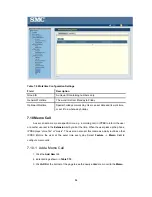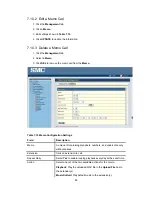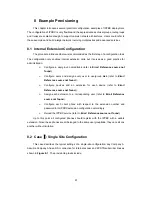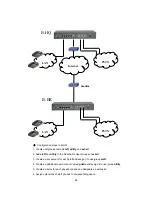
91
8 Example Provisioning
This chapter introduces several practical configuration examples of IPPBX deployment.
The configuration of IPPBX is very flexible and the expressiveness of usergroups, routegroups,
and trunks are scalable enough to support various network architectures. Users could refer to
these examples and build a larger network involving multiple sites and advanced services.
8.1 Internal Extension Configuration
The procedure introduced below is recommended as the first step of a configuration task.
The configuration only enables internal extension calls, but it serves as a good practice for
administration.
!
Configure a usergroup named
ALL
(refer to
Error! Reference source not
found.
).
!
Configure users and assign every user to usergroup
ALL
(refer to
Error!
Reference source not found.
).
!
Configure devices and an extension for each device (refer to
Error!
Reference source not found.
).
!
Assign each extension to a corresponding user (refer to
Error! Reference
source not found.
).
!
Configure each client phone with respect to the extension number and
password in its IPPBX extension configuration accordingly.
!
Reload the IPPBX service (refer to
Error! Reference source not found.
).
Up to this point all configured phones should register with the IPPBX with a usable
extension. Since these phones are all belonged to the same usergroup
ALL
, they can call one
another without limitation.
8.2 Case
Ⅰ
: Single Site Configuration
This case describes the typical settings of a single-site configuration; say Company A.
Assume Company A has a DSL connection for Internet access and 2 PSTN subscriber lines as
shown in
Figure 8-1
. The provisioning tasks include:
Summary of Contents for PBX10 FICHE
Page 1: ...SMCPBX10 TigerVoIP IP PBX Telephony System USER GUIDE TM...
Page 2: ......
Page 132: ...SMCPBX10...


































